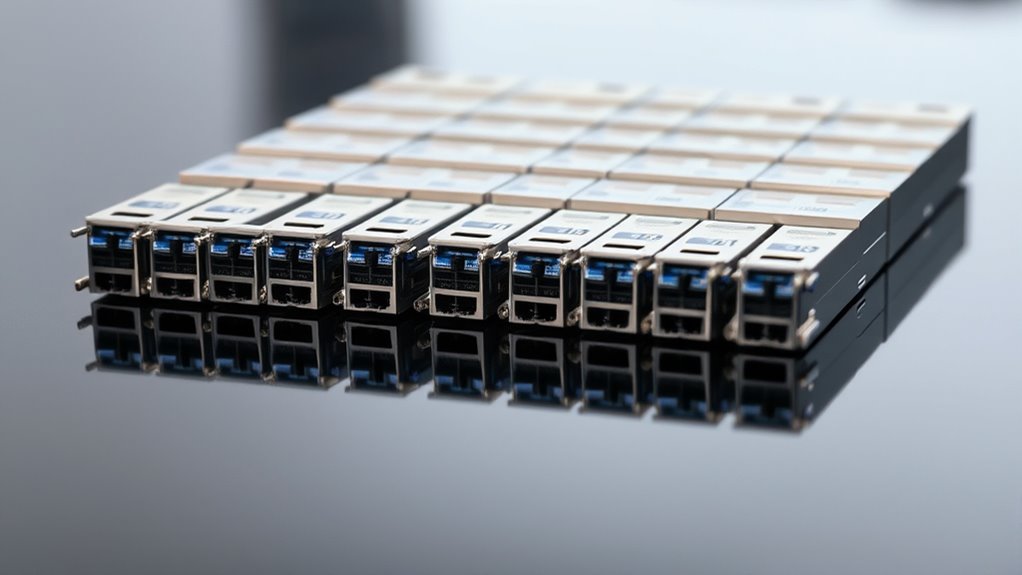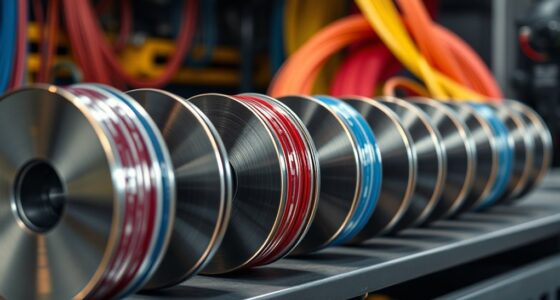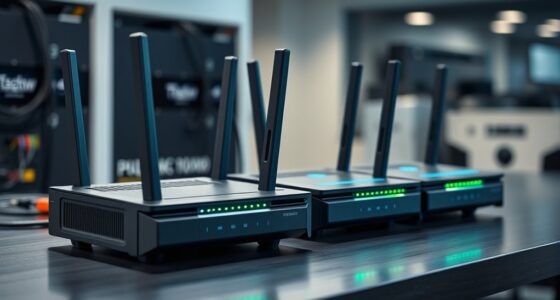I’ve researched the top single-mode fiber transceivers ideal for high-speed data transmission in 2025. From compact SFP+ modules supporting 10Gbps over 10 km to Bidi converters reaching 30 km, these devices are reliable and compatible with major brands like Cisco, Ubiquiti, and MikroTik. They feature features like DDM, low power consumption, and plug-and-play setup. If you want to learn which models fit your needs, keep going—there’s more to explore.
Key Takeaways
- Focus on transceivers supporting 10Gbps to 100Gbps over single-mode fiber for high-speed backbone networks.
- Prioritize models with advanced diagnostics, real-time monitoring, and compatibility with major brands like Cisco and Ubiquiti.
- Consider long-distance capabilities up to 30 km with wavelengths of 1310nm or 1550nm for extended reach.
- Evaluate energy efficiency features, plug-and-play design, and robust environmental performance for reliable deployment.
- Select transceivers with industry-standard compliance, high reliability, and warranty support suitable for enterprise-grade applications.
Single Mode LC WDM Fiber Media Converter with Built-in Module
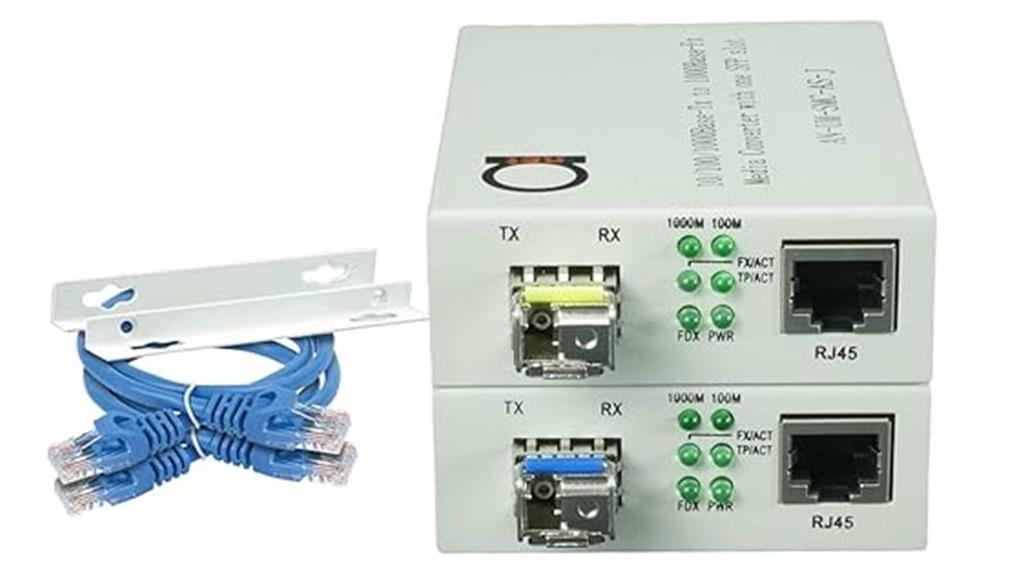
If you’re looking for a reliable solution to extend Ethernet over long distances, the Single Mode LC WDM Fiber Media Converter with Built-in Module is an excellent choice. It can transmit Ethernet signals up to 20 km using a single fiber, thanks to its WDM technology with 1310nm and 1550nm wavelengths. The plug-and-play design makes setup easy—just connect your fiber and Ethernet cables. It supports auto-adapting speeds from 10 Mbps to 1 Gbps, ensuring compatibility with various network setups. Plus, it includes mounting accessories and a free patch cable, making installation straightforward without any complex configuration.
Best For: those seeking a reliable, long-distance fiber optic Ethernet extension solution for enterprise or industrial networks.
Pros:
- Supports transmission distances up to 20 km over a single fiber using WDM technology.
- Plug-and-play design for easy installation without complex configuration.
- Supports auto-adapting speeds from 10 Mbps to 1 Gbps, ensuring broad compatibility.
Cons:
- Requires compatible UPC (Blue) Type fiber patch cords for optimal performance.
- Colors of units may vary, potentially affecting inventory management.
- Limited to single fiber WDM setup, which may not suit more complex fiber network configurations.
H!Fiber 10G Single Mode SFP+ LC Module (2 Pack)

The H!Fiber 10G Single Mode SFP+ LC Module (2 Pack) is an excellent choice for network professionals seeking reliable, high-speed fiber connectivity over distances up to 10km. It supports 10Gbps transfer via 1310nm wavelength on single-mode fiber, with duplex LC connectors for easy installation. Compatible with a wide range of devices, including Cisco, Mikrotik, Ubiquiti, and others, it offers plug-and-play operation and hot-swapping capabilities. Its advanced features include Digital Diagnostics Monitoring (DDM), low power consumption, and EMI protection, making it ideal for enterprise and high-performance networks requiring stable, long-distance links.
Best For: network professionals and enterprises seeking reliable, high-speed fiber connections over distances up to 10km with plug-and-play simplicity.
Pros:
- Supports 10Gbps data transfer over single-mode fiber up to 10km, ideal for long-distance links.
- Compatible with a wide range of devices including Cisco, Mikrotik, Ubiquiti, and more, ensuring versatility.
- Features advanced Digital Diagnostics Monitoring (DDM), low power consumption, and EMI protection for stable performance.
Cons:
- Does not support DDM, limiting real-time line condition monitoring.
- Some units may run hot during operation, which can concern users if not properly managed.
- Occasionally reports as multi-mode SR modules, which may cause confusion but does not affect functionality.
H!Fiber 1.25G Single Mode SFP LC Module (2 Pack)
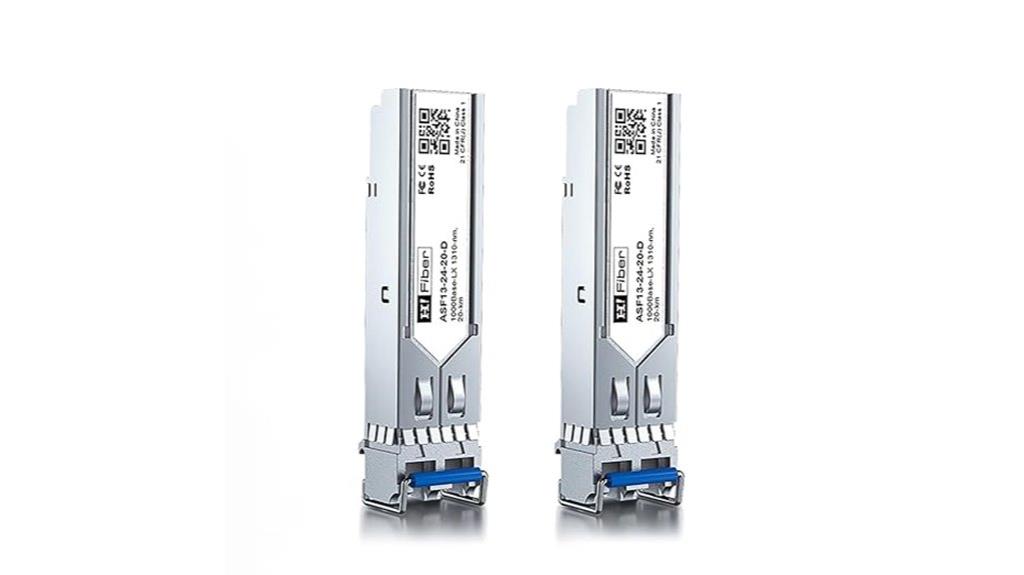
For network professionals seeking reliable gigabit connectivity over long distances, the H!Fiber 1.25G Single Mode SFP LC Module (2 Pack) stands out as an excellent choice. Supporting 1000Base-LX/LH standards, it delivers 1.25 Gb/s data transfer over single-mode fiber up to 20 km. Its 1310nm wavelength guarantees stable performance, while the duplex LC interface simplifies connections. The module features advanced DDM for real-time link monitoring and is hot-swappable for easy deployment. Compatibility spans a wide range of devices, including Cisco, Ubiquiti, Mikrotik, and more. With low power consumption and robust protection, it offers reliable, energy-efficient operation for demanding network environments.
Best For: network professionals requiring reliable gigabit fiber connectivity over long distances with easy deployment across various compatible devices.
Pros:
- Supports up to 20 km transmission distance for extended network coverage
- Compatible with a wide range of brands including Cisco, Ubiquiti, MikroTik, and more
- Features advanced DDM for real-time fiber link monitoring and hot-swappable design for easy installation
Cons:
- Limited to single-mode fiber applications, not suitable for multimode fiber setups
- Requires compatible fiber cables with duplex LC/UPC connectors for optimal performance
- May have higher upfront cost compared to lower-speed or multimode options
A Pair of 1.25G/s Bidi Gigabit Single-Mode Fiber Ethernet Media Converter

A pair of 1.25G/s Bidi Gigabit Single-Mode Fiber Ethernet Media Converters are ideal for network professionals seeking reliable, long-distance fiber links. These converters support bidirectional 1.25Gbps fiber connections with included SFP LC transceivers, allowing seamless conversion between RJ45 Ethernet and single-mode fiber up to 30 kilometers. They feature plug-and-play operation, making setup straightforward. With status LEDs for easy monitoring and wide voltage support, they they guarantee stability and versatility. Backed by 15 years of OEM experience and a money-back guarantee, these converters provide a dependable solution for extending high-speed network connectivity over long distances.
Best For: network professionals and organizations requiring reliable, long-distance high-speed fiber connections up to 30 km.
Pros:
- Supports bidirectional 1.25Gbps fiber links with included SFP transceivers for seamless conversion
- Plug-and-play setup with status LEDs for easy network monitoring
- Wide voltage range and 15-year OEM support ensure stability and versatility
Cons:
- Limited to single-mode fiber with a maximum distance of 30 km, not suitable for shorter or multi-mode applications
- Requires compatible fiber and RJ45 cabling, which may add to installation costs
- Operational temperature range from 0°C to 60°C may not suit extreme environments
10GTEK 1.25G SFP Transceiver for Cisco and Ubiquiti
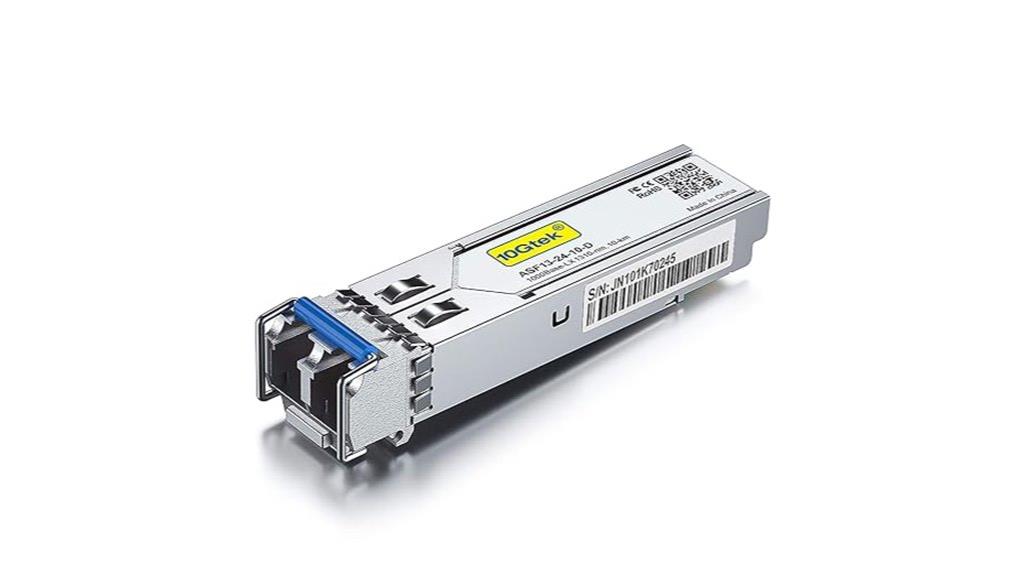
If you’re seeking a reliable, plug-and-play fiber transceiver compatible with popular networking equipment, the GTEK 1.25G SFP Transceiver is an excellent choice. Supporting 1000BASE-LX/LH standards, it transmits data at 1.25Gbps over single-mode fiber up to 10 km. Its duplex LC connectors and DDM for real-time monitoring make installation straightforward and efficient. Fully compliant with SFP MSA and IEEE standards, it works seamlessly with Cisco, Ubiquiti, and other open switches. Designed for outdoor and indoor use, it offers stable, high-performance connections without additional configuration, making it ideal for backbone links, fiber switches, routers, and network upgrades.
Best For: network administrators and IT professionals seeking reliable, easy-to-install fiber transceivers compatible with Cisco, Ubiquiti, and other open networking equipment for long-distance fiber connections.
Pros:
- Plug-and-play, easy installation without additional configuration
- Supports real-time monitoring via DDM for optimal performance management
- Fully compliant with industry standards, ensuring broad compatibility and reliable operation
Cons:
- Limited to single-mode fiber with a maximum transmission distance of 10 km
- May require specific fiber cable types (OS1/OS2/OS3) for optimal performance
- No built-in support for multi-mode fiber or longer reach beyond 10 km
Gigabit Single Mode LC Fiber Media Converter (2 Pcs SFP LX Modules)
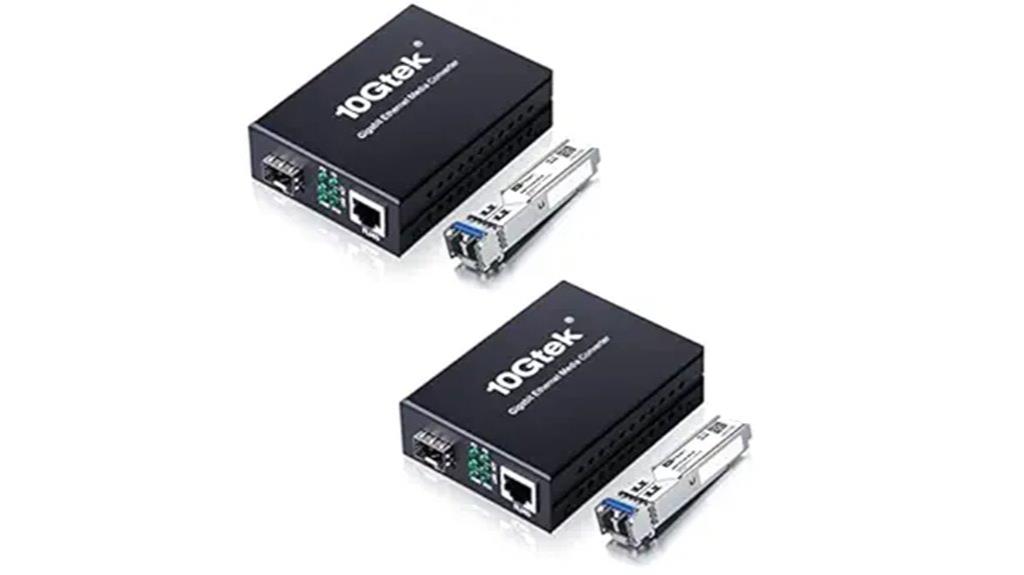
The Gigabit Single Mode LC Fiber Media Converter with 2 SFP LX Modules is an excellent choice for network professionals seeking reliable long-distance fiber-to-ethernet conversion. It includes two SFP to RJ45 media converters, two single-mode 1000Base-LX modules, power supplies, and a manual, backed by a 3-year warranty and lifetime support. Supporting up to 20km over single-mode fiber with dual LC connectors, it offers stable 1000Mbps Ethernet, compatible with 10/100 Mbps. Plug-and-play design requires no configuration, while LED indicators simplify monitoring. Its compliance with IEEE standards ensures dependable performance, making it ideal for extending networks across long distances seamlessly.
Best For: network professionals and organizations seeking reliable long-distance fiber-to-ethernet connectivity with easy installation and minimal configuration.
Pros:
- Supports up to 20km transmission distance over single-mode fiber for long-range networking.
- Plug-and-play design with no configuration required, simplifying setup.
- Includes comprehensive package with two media converters, SFP modules, power supplies, and a manual, backed by a 3-year warranty and lifetime support.
Cons:
- Limited to single-mode fiber applications; not suitable for multimode fiber networks.
- Requires compatible fiber cabling and connectors (dual LC) for proper operation.
- May be more expensive compared to basic Ethernet switches for short-distance networking.
4Pack SFP+ 10GBase-LR LC Module for Fiber Optic Transceivers
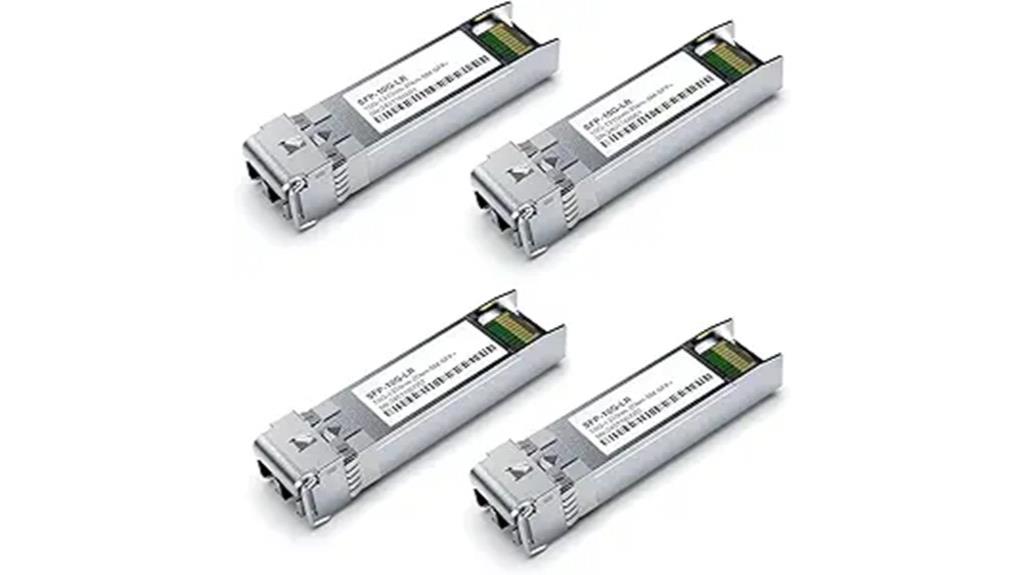
Ideal for data centers and enterprise networks requiring reliable long-distance fiber links, the Pack SFP+ 10GBase-LR LC Module offers high-speed 10Gbps connectivity over 20km of single-mode fiber. It features a 1310nm wavelength, low power consumption (<1.05W), and advanced ESD protection, ensuring stable performance. Compatible with major brands like Cisco, Ubiquiti, and MikroTik, it easily integrates with switches, routers, and servers. The plug-and-play design simplifies installation, while real-time diagnostics help monitor performance. Customers praise its reliability, affordability, and ease of use, making it an excellent choice for extending high-speed fiber connections over long distances.
Best For: enterprises, data centers, and network professionals seeking reliable, long-distance 10Gbps fiber connectivity over single-mode fiber up to 20km.
Pros:
- High-speed 10Gbps performance with stable long-distance connections up to 20km
- Easy plug-and-play installation with hot-swappable design
- Compatible with major brands like Cisco, Ubiquiti, and MikroTik, and supports real-time diagnostics
Cons:
- Some Linux systems may require driver adjustments for optimal operation
- Slightly higher cost compared to lower-speed or multi-mode options
- Limited to single-mode fiber, not suitable for shorter-range or multi-mode applications
ipolex Gigabit Single-Mode LC Fiber to Ethernet Media Converter
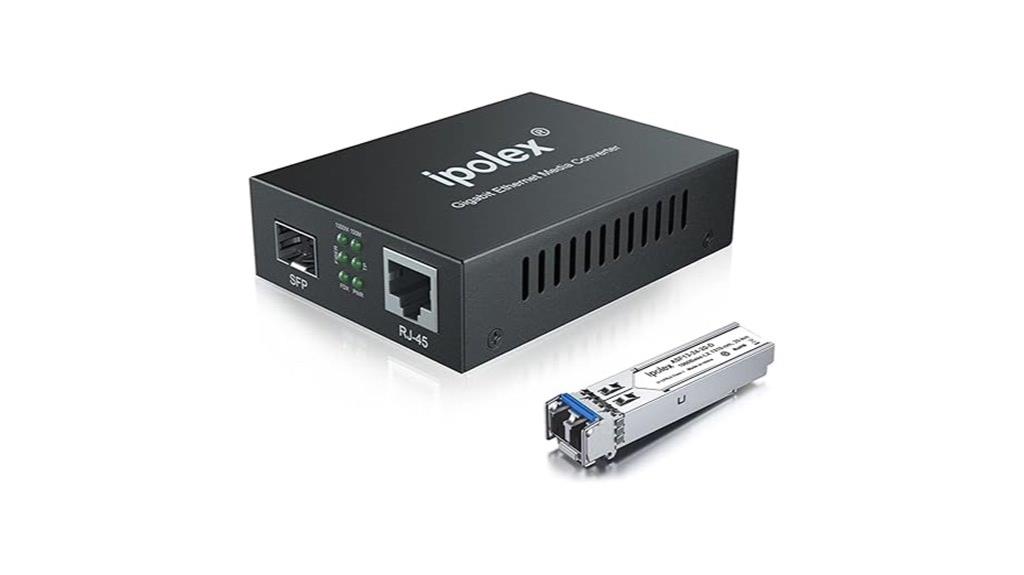
For network professionals seeking a straightforward solution to extend Gigabit Ethernet over long distances, the ipolex Gigabit Single-Mode LC Fiber to Ethernet Media Converter stands out. It converts 1000BASE-LX fiber to RJ-45 Ethernet, supporting up to 20 km via OS1/OS2 single-mode fiber. With a plug-and-play design, it requires no software or configuration, and hot-swappable components make installation easy. Supporting auto-negotiation, auto-MDI/MDIX, and full/half duplex modes, it offers reliable, near gigabit speeds. Its stability over months, electrical isolation, and compatibility with various SFP modules make it ideal for building, remote, and outdoor installations, providing a dependable, cost-effective fiber-to-Ethernet link.
Best For: network professionals and organizations seeking a simple, reliable, and cost-effective solution to extend Gigabit Ethernet connections over long distances using single-mode fiber.
Pros:
- Plug-and-play design requiring no software or configuration, enabling quick setup.
- Supports extended transmission distances up to 20 km with single-mode fiber for long-range links.
- Provides electrical isolation and compatibility with various SFP modules, ensuring stable and versatile operation.
Cons:
- Requires matching fiber type (single-mode OS1/OS2) and proper cable configuration for optimal performance.
- Occasional reports of defective units may necessitate replacements for consistent reliability.
- Limited to fiber-to-Ethernet conversion; not suitable for non-Gigabit or multi-mode fiber applications.
H!Fiber 1.25G Single Mode SFP LC Module 2 Pack
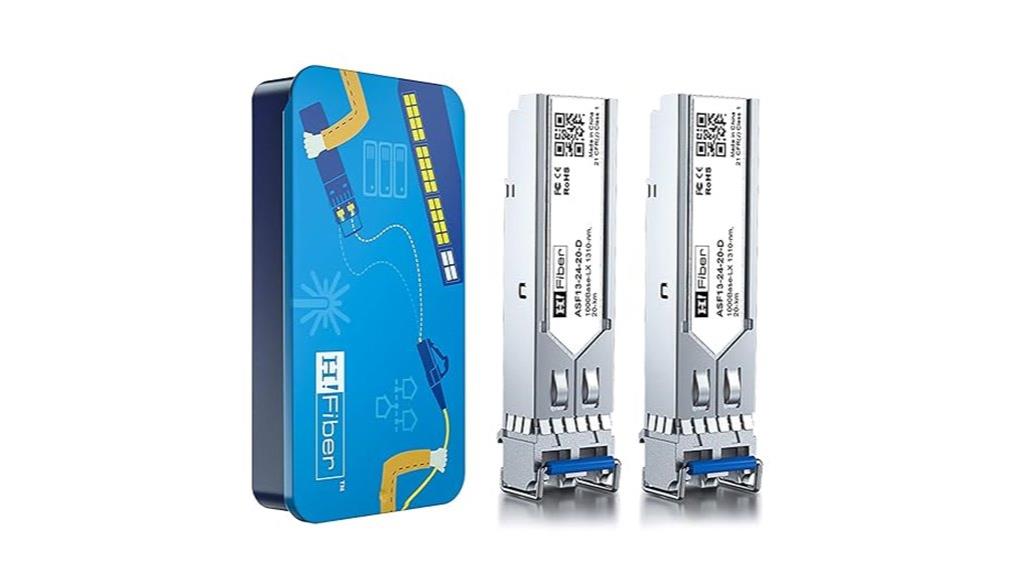
If you’re upgrading a fiber network and need reliable, cost-effective transceivers, the H!Fiber 1.25G Single Mode SFP LC Module 2 Pack stands out as a smart choice. These modules support 1.25 Gb/s Ethernet over single-mode fiber up to 20km, with duplex LC connectors ensuring easy installation. Compatible with brands like Cisco, Ubiquiti, Mikrotik, and more, they offer plug-and-play operation and digital diagnostics. Ideal for both home and enterprise setups, they’re tested for stability and low latency. Buying in packs makes them cost-efficient, and they’re perfect for extending fiber links or upgrading existing infrastructure with minimal fuss.
Best For: home and enterprise users seeking reliable, cost-effective fiber transceivers for extending or upgrading their fiber networks over single-mode fiber up to 20km.
Pros:
- Compatible with a wide range of equipment including Cisco, Ubiquiti, Mikrotik, and more, ensuring versatile deployment.
- Supports hot-swappable, plug-and-play operation with advanced digital diagnostics for easy monitoring.
- Cost-effective when purchased in packs, ideal for scalable network upgrades and long-distance fiber links.
Cons:
- Some units may arrive defective or incompatible, requiring testing before deployment.
- Runs warm under 10GbE operation, necessitating proper airflow management.
- Performance can vary depending on hardware compatibility, potentially causing negotiation or stability issues.
Single Mode ST Gigabit Fiber Media Converter
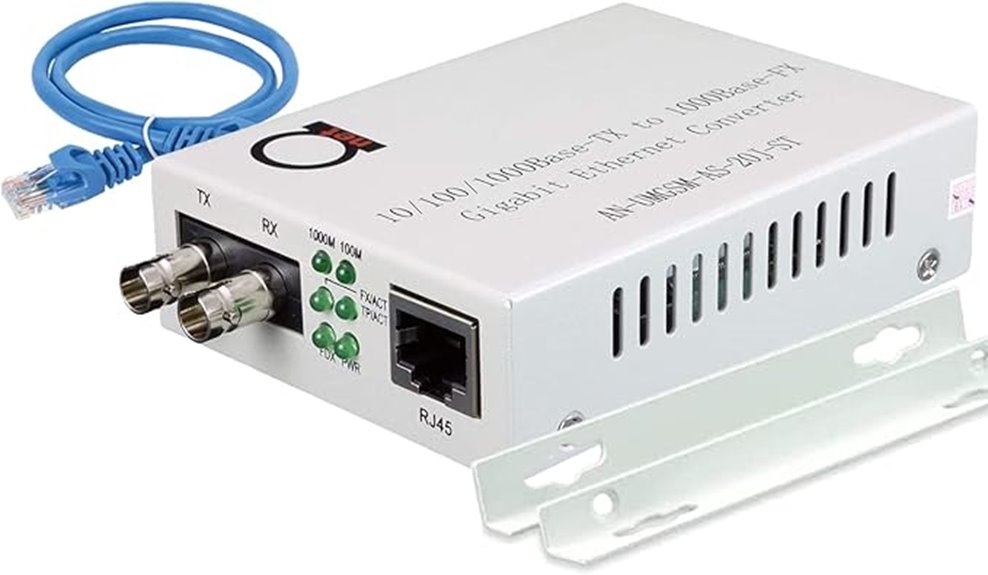
The Single Mode ST Gigabit Fiber Media Converter stands out for its ability to transmit data over long distances—up to 20 km—making it a top choice for network professionals who need reliable, high-speed connections across extensive fiber networks. Its built-in fiber module supports seamless auto-sensing for Gigabit or Fast Ethernet, adapting to 10 Mbit/s, 100 Mbit/s, or 1000 Mbit/s speeds. Equipped with a dual-speed fiber mode, it’s versatile for various setups. The converter’s plug-and-play design simplifies installation, while features like jumbo frames and LLF enhance TCP performance. Compatible with ST to UTP Cat5e/Cat6 interfaces, it guarantees smooth integration into existing network infrastructures.
Best For: network professionals seeking reliable, long-distance fiber optic connections for high-speed data transmission over extensive networks.
Pros:
- Supports transmission distances up to 20 km, ideal for long-range applications
- Auto-sensing for Gigabit and Fast Ethernet speeds ensures versatile connectivity
- Plug-and-play design simplifies installation and deployment
Cons:
- Limited to Single Mode Fiber with a wavelength of 1310 nm, reducing compatibility with other fiber types
- May require additional fiber components for complex network setups
- Comes with only a 1-meter patch cable, which might necessitate longer cables for certain installations
10Gtek Pair of 10G SFP+ Bidi Transceivers
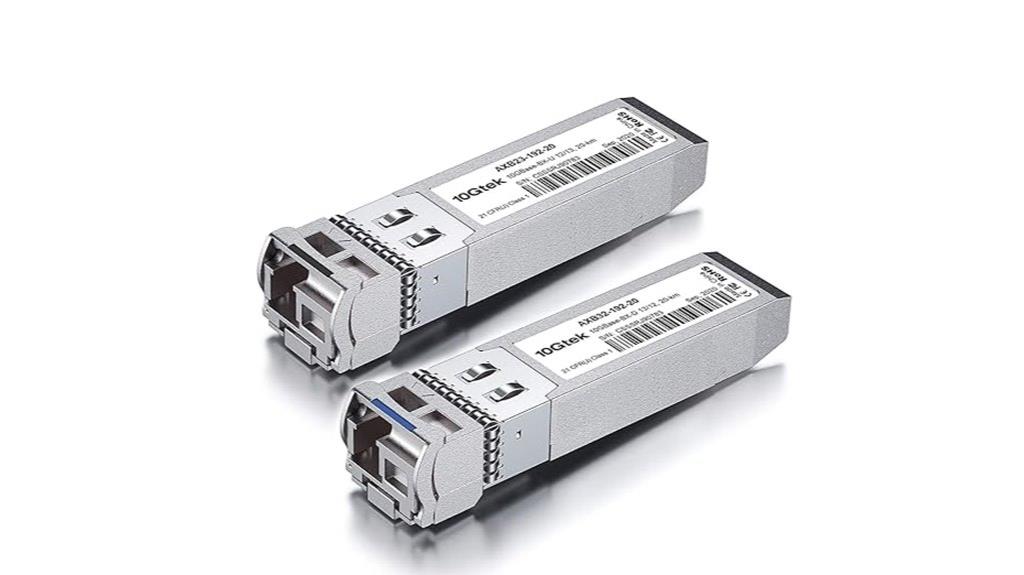
When looking to connect long-distance fiber links with high reliability, the Gtek Pair of 10G SFP+ Bidi Transceivers stands out as an excellent choice. These modules support 10GBASE-BIDI standards, enabling bi-directional data transfer over a single fiber up to 20 kilometers. They feature wavelengths of 1270nm and 1330nm, making installation straightforward across compatible network devices like Cisco, Ubiquiti, and Mikrotik. Fully hot-pluggable and rigorously tested, they ensure seamless operation. Plus, with digital diagnostic monitoring, I can proactively manage performance. Backed by a 3-year warranty and lifetime support, these transceivers deliver high-speed, long-distance connectivity with confidence.
Best For: network administrators and IT professionals seeking reliable, long-distance high-speed fiber connections for enterprise or data center applications.
Pros:
- Supports 10GBASE-BIDI for efficient bi-directional data transfer over a single fiber up to 20 km.
- Fully hot-pluggable for easy installation and replacement without system downtime.
- Equipped with Digital Diagnostic Monitoring (DDM) for real-time performance tracking and proactive management.
Cons:
- Compatible primarily with specific network devices supporting 10G SFP+ ports, limiting flexibility with non-standard equipment.
- Requires single-mode fiber infrastructure, which may involve higher installation costs.
- May need careful handling and proper fiber management due to long-distance optical connections.
Bidi Gigabit Fiber Ethernet Media Converter with SFP Modules
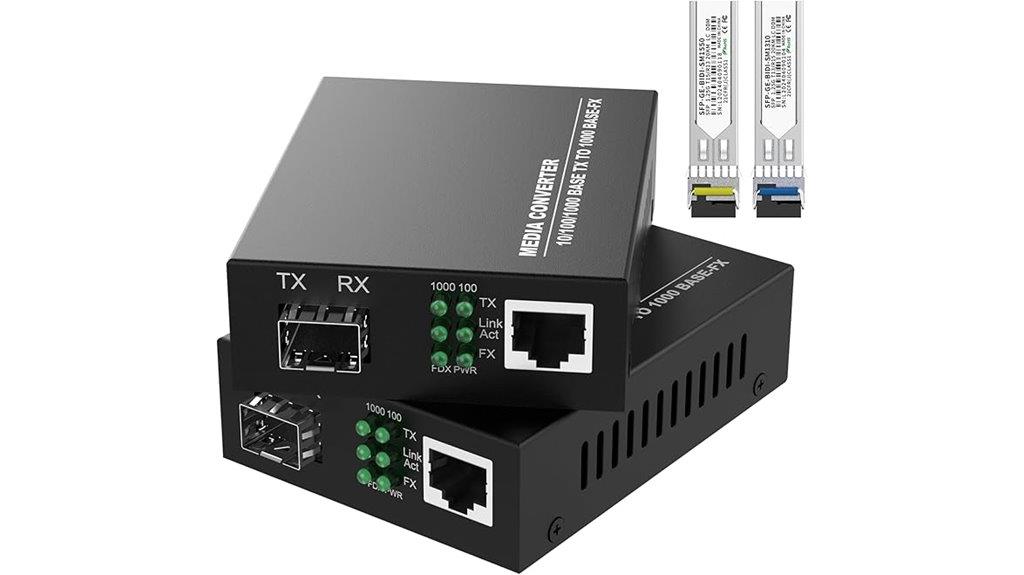
Designed for enterprise and data center environments, the Bidi Gigabit Fiber Ethernet Media Converter with SFP Modules offers a reliable, plug-and-play solution for extending high-speed networks over long distances. It includes two media converters supporting up to 30 km over single-mode fiber and features BiDi SFP transceivers at 1310nm/1550nm wavelengths. Supporting 1.25Gbps data transfer, auto-negotiating RJ45 ports, and durable metal enclosures, it guarantees stable, interference-resistant links. Its compact, hot-swappable design makes installation straightforward, ideal for network expansion, bridging, and secure connectivity across campuses, remote buildings, or sensitive environments requiring reliable, long-distance fiber optic transmission.
Best For: network administrators and IT professionals seeking a reliable, long-distance fiber optic extension solution for enterprise, data center, or campus environments.
Pros:
- Supports transmission distances up to 30 km over single-mode fiber for extended network reach
- Plug-and-play design with hot-swappable modules for easy installation and maintenance
- Durable metal enclosure with heat dissipation features suitable for various environmental conditions
Cons:
- Limited to 1.25Gbps data transfer rate, which may not meet ultra-high-speed requirements of some applications
- Requires compatible SFP modules (BiDi LC SFP transceivers) for operation, adding to initial setup cost
- Operating temperature range (0°C to 60°C) may not fit in extremely hot or cold environments
Factors to Consider When Choosing a Single‑Mode Fiber Transceiver

When selecting a single‑mode fiber transceiver, I consider factors like compatibility with existing equipment and the required transmission distance. It’s also important to match the wavelength specifications and guarantee the data transfer speed aligns with my network needs. Additionally, I look at power consumption to find a solution that’s efficient and suitable for my setup.
Compatibility With Equipment
Choosing a single-mode fiber transceiver that seamlessly integrates with your existing network equipment requires careful attention to compatibility. First, I verify that the transceiver complies with industry standards like SFP MSA and IEEE 802.3z, ensuring broad compatibility across devices. I also check that it matches my equipment’s SFP or SFP+ ports and supports the required data rates, whether 1Gbps or 10Gbps. Confirming that the wavelength and distance specifications align with my fiber optic cables is essential for maximum performance. If I need real-time monitoring, I look for features like Digital Diagnostics Monitoring (DDM). Finally, I ensure the transceiver is compatible with my device brands and models to prevent interoperability issues, making integration smooth and reliable.
Transmission Distance Limits
The transmission distance of a single-mode fiber transceiver is a critical factor that depends on several key elements. Primarily, the wavelength used—either 1310 nm or 1550 nm—plays a significant role, as longer wavelengths generally support greater distances. The quality of the fiber optic cable also impacts how far signals can travel; higher quality fibers with fewer imperfections enable longer runs. Signal attenuation naturally increases over distance, which can limit effective transmission without amplifiers or repeaters. To maintain reliable data integrity over longer distances, transceivers need higher optical power output and lower receiver sensitivity. Additionally, environmental factors such as connector losses, fiber quality, and external interference can further influence how far signals can reliably reach.
Wavelength Specifications
Selecting the appropriate wavelength is essential for optimizing a single-mode fiber transceiver’s performance over long distances. Typically, these transceivers operate at 1310nm or 1550nm, wavelengths chosen for their ability to minimize signal loss over extended links. The 1310nm wavelength supports transmission distances of 20km or more with minimal attenuation, making it ideal for many applications. Wavelength selection also impacts dispersion and attenuation, which directly influence how far signals can reliably travel. Compatibility with the fiber type is critical; mismatched wavelengths can cause performance issues or signal degradation. Unlike multimode transceivers operating at 850nm, single-mode transceivers demand precise wavelength specifications to ensure optimal, long-range performance. Choosing the correct wavelength ensures your network maintains high quality and stability over distance.
Data Transfer Speed
Data transfer speed is a critical factor when evaluating single-mode fiber transceivers because it directly impacts your network’s performance and capacity. These transceivers support speeds from 1Gbps up to 10Gbps and beyond, depending on the module specifications. The maximum data rate determines whether the transceiver can handle high-bandwidth applications like data centers, enterprise networks, or backbone links. Higher speeds often require compatible equipment and fiber cables that can sustain increased throughput without signal loss. Keep in mind that actual speeds may vary based on network conditions, cable quality, and the capabilities of connected devices. Choosing a transceiver with the right speed support ensures your network remains efficient, scalable, and prepared for future demands.
Power Consumption Needs
Considering power consumption is essential when choosing a single-mode fiber transceiver, especially for large or energy-conscious networks. Lower power transceivers, typically under 1 watt, help reduce energy costs and support sustainable operations over time. High power consumption can generate excess heat, requiring additional cooling solutions that add complexity and expense. Selecting transceivers with energy-saving features like Digital Diagnostic Monitoring (DDM) or low-power modes can further decrease overall energy needs. Consistent power requirements across devices ensure stable operation and minimize the risk of network disruptions caused by power fluctuations. Understanding the power consumption specifications allows for better planning of power supply capacity and helps control energy costs, particularly important in large-scale deployments where efficiency impacts the bottom line.
Installation Requirements
When installing a single-mode fiber transceiver, verifying compatibility with your existing hardware is a key step. Make certain the transceiver’s form factor and interface types, like SFP or SFP+, match your network equipment. Confirm that the power supply requirements align with your available outlets and that the operating temperature range suits your environment. Check that the fiber optic connectors, such as LC or ST, and wavelength specifications are compatible with your existing fiber cabling. It’s also important to verify if the transceiver supports hot-swapping, allowing maintenance without network disruption. Finally, follow the manufacturer’s instructions carefully for insertion and removal to avoid damaging the transceiver or fiber connectors. Proper compatibility and installation practices ensure a smooth setup and reliable performance.
Monitoring Capabilities
Have you ever wondered how to make certain your fiber optic link remains reliable over time? Monitoring capabilities are key. Many single-mode fiber transceivers include Digital Diagnostics Monitoring (DDM), which tracks real-time data like temperature, voltage, optical power, and bias current. These features allow me to proactively manage the network, catching potential issues early before they lead to failures. They also simplify troubleshooting and maintenance, reducing downtime and boosting overall reliability. However, not all transceivers support these advanced functions, so it’s vital to verify if DDM or similar features are included in the specifications. Effective monitoring helps guarantee long-distance links perform at their best by continuously evaluating line conditions and signal quality, giving me confidence in the stability and performance of my high-speed data transmission network.
Price and Budget
Are you aware of how much your budget influences the choice of a single-mode fiber transceiver? Prices vary widely, from around $20 to over $500, depending on speed, distance, and features. Budget models typically support 1G or 10G speeds over shorter distances, making them suitable for smaller networks. Higher-priced options offer longer reach, up to 80 km or more, and include advanced features like diagnostic capabilities and industry-standard compliance. Your budget determines not only what features you get but also guarantees compatibility with existing equipment and future scalability. Finding the right balance between cost and performance is essential; overspending on unnecessary features wastes money, while underinvesting risks network reliability. Carefully assess your needs to choose a transceiver that fits your budget and long-term goals.
Frequently Asked Questions
How Do Environmental Factors Affect Single-Mode Fiber Transceiver Performance?
Environmental factors like temperature fluctuations, humidity, and vibration can considerably impact single-mode fiber transceiver performance. I’ve seen how extreme temperatures cause signal attenuation or even damage to the fiber. Humidity can lead to corrosion or moisture ingress, while vibrations can disrupt the delicate alignment of the transceiver. To guarantee ideal performance, I always recommend proper installation, protective enclosures, and regular maintenance to mitigate these environmental effects.
What Are the Compatibility Considerations for Different Transceiver Brands?
When it comes to transceiver brands, compatibility is key—think of it like fitting puzzle pieces together. I make sure the transceivers match the equipment’s specifications and use industry standards, like SFP+ or QSFP28. I also double-check the vendor’s compatibility list to avoid surprises. Mixing brands can work, but I prefer sticking to trusted combinations to guarantee seamless operation and avoid potential headaches down the line.
How Does Transceiver Latency Impact High-Frequency Data Transmission?
Transceiver latency directly affects high-frequency data transmission by determining how quickly data is processed and sent over the network. When latency is low, data moves faster, reducing delays and improving overall performance. High latency can cause bottlenecks, jitter, and data loss, especially in real-time applications. I always prioritize low-latency transceivers to guarantee smooth, high-speed communication, especially for demanding data center and enterprise environments.
What Are the Future Trends in Single-Mode Fiber Transceiver Technology?
Imagine a relay race where each runner gets faster and more precise—that’s how I see future single-mode fiber transceiver tech evolving. I expect we’ll see significant improvements in bandwidth, miniaturization, and energy efficiency, like sleek athletes pushing limits. Innovations in photonics and integration will make transceivers smarter and more adaptable, ensuring high-speed data flows seamlessly, making our networks more resilient and capable of handling the data demands of tomorrow.
How Can I Troubleshoot Common Issues With Single-Mode Fiber Transceivers?
When troubleshooting common issues with single-mode fiber transceivers, I start by checking the physical connections for damage or dirt. I verify the transceivers are compatible and properly seated. Then, I verify the link status and use diagnostic tools like OTDRs to detect faults or signal loss. Finally, I review the device logs and firmware updates to rule out software issues, guaranteeing the best performance.
Conclusion
Choosing the right single-mode fiber transceiver is like picking the perfect key for a lock—each one opens up high-speed data channels smoothly and reliably. With so many options, you’ll find the ideal match to facilitate seamless, high-performance connections. Think of these transceivers as the bridges spanning vast networks, carrying your data swiftly across the digital landscape. Picking the right one guarantees your data flows effortlessly, connecting you to the future of high-speed communication.
